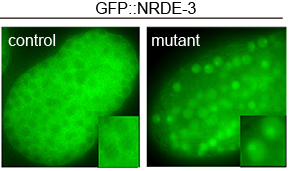USTC Uncovers the Secret of Small Interfering RNA
]
Recently, a team led by Prof. GUANG Shouhong from the University of Science and Technology of China (USTC) have made progress in biological processes, functions and regulatory mechanisms of small interfering RNA, which is widely neglected as garbage sequence. And the findings may contribute to the treatment of human Perlman's disease.For a long time, small fragments of ribosomal RNA have been widely considered by the research community as non-specific degradation products and neglected as garbage sequence. Little is known about their biological processes, functions and regulatory mechanisms. GUANG's team found that a new class of antisense ribosomal siRNAs (risiRNAs) downregulate pre-rRNA through a nuclear RNAi pathway. The risiRNAs are sensitive to environmental stimuli and gene mutations. When a gene SUSI-1(ceDis3L2) is mutated, risiRNAs are dramatically increased. Interesting, this SUSI-1(ceDis3L2) mutation is also identified in a human disease called Perlman's syndrome. Therefore, this study not only discovered a new mechanism to maintain RNA steady state in cells, but also is of great significance for the treatment of human Perlman's disease.

Figure: risiRNA elicits the cytoplasm-to-nucleoli translocation of NRDE-3 to silence pre-rRNA. (Image by GUANG Shouhong)
The work is titled RdRP-synthesized antisense ribosomal siRNAs silence pre-rRNA via the nuclear RNAi pathway in the February 6 online issue of the journalNature Structure and Molecular Biology. Dr. ZHOU Xufei and FENG Xuezhu are the co-first authors. The National Science Foundation of China (NSFC) and the University of Science and Technology of China (USTC) provide finance support.
Article link: http://www.nature.com/nsmb/journal/vaop/ncurrent/full/nsmb.3376.html
Back
